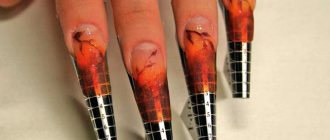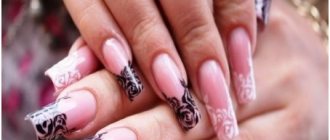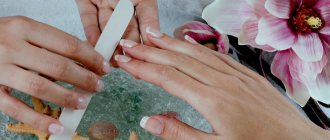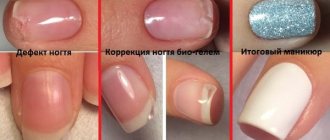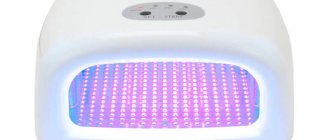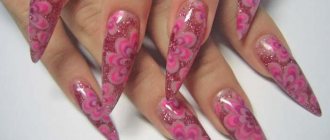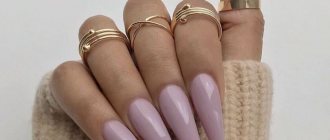Nail extensions are one of the most popular nail salon services, which solves the problem of a perfect manicure for the modern woman. But for some reason, some masters recommend only gel, while others definitely recommend acrylic. Where is the truth? Let’s try to understand the intricacies of gel and acrylic nail extensions and answer the question: “Which material is better: gel or acrylic?”
What is more harmful: gel or acrylic?
More often than others, you can come across the opinion that acrylic is harmful to nails, as it has a more “nuclear” composition. This is nothing more than a myth. You need to know that both gel and acrylic are acrylates, that is, they have a similar chemical composition and affect the nail plate in approximately the same way. However, there are known cases of allergies to both materials. Neither gel nor acrylic extensions will make your own nails healthier and stronger; moreover, after either of these two procedures they will require restoration. Therefore, none of the materials being compared is more beneficial or harmful than the other.
What is the difference between acrylic and gel?
Nail extension gel is a fluid substance that looks like polish and spreads over the nail much like regular nail polish. Gels are either photosensitive (harden when exposed to UV rays) or non-photosensitive (requires a catalyst to harden). You can also find single-phase, two-phase and three-phase extension gels. The gel has no odor, which is its huge advantage.
With acrylic everything is both simpler and more difficult at the same time. Acrylic is a powder that, when mixed with a special liquid (liquid, monomer), turns into a thick plastic substance that quickly hardens in air. Acrylic does not flow and does not require any special means for hardening. But they need to work quickly, as it hardens within a few minutes. The big disadvantage of acrylic is the strong “dental” smell of the liquid.
The difference between gel and acrylic is described in great detail in the video:
Which gel is better to choose?
The gel is selected depending on functionality and is divided into several systems:
- single-phase system - one gel is used, which has all the functions. They perform all extension manipulations - adhesion, modeling, strength;
- two-phase system - consists of two gels, one of which is used for adhesion and modeling, the other as a top durable coating;
- three-phase system - includes three components. The first gel ensures safe interaction between the artificial material and the nail, the second gel models the shape of the plate, the third provides strength, shine and smoothness.
The best gels for nail extensions are those that have a quality certificate. Popular brands include Top Gloss Gel, Planet Nails, CNI, EzFlow, Irisk, RuNail, IBD, TNL, Severina, Masura.
Nail extension with gel and acrylic: technology features
Both gel and acrylic can be applied to natural nails, and can also be used for extensions on tips or forms. Many people believe that acrylic extensions are longer and more complex, but objectively both procedures last approximately the same and contain a similar set of steps.
For both types of extensions, the procedure consists of three steps:
- Preparing the nail plate and applying primer (bonder).
- The actual application of the modeling material.
- Applying the finishing coat.
The first and third stages of extensions with gel or acrylic are almost the same, the difference is noticeable only at the second stage and it is associated with the peculiarities of the “behavior” of the gel or acrylic.
The gel is applied to the nail with a brush, like varnish, and then cured using a UV lamp or catalyst. If an error occurs when applying the gel (flowing behind the cuticle, etc.), after hardening it can only be eliminated by filing it down; in serious cases, the nail will have to be completely redone.

Photo: lucina.ru
Unlike gel, the acrylic composition must first be “cooked”. The brush is dipped in liquid, then in acrylic powder, as a result a ball is formed at the tip of the brush, which must be carefully transferred to the nail and quickly distributed. An already hardened coating can be easily corrected using a special acrylic softening composition. The acrylic coating is absolutely impenetrable, so fungus can grow under it during wear. To prevent this from happening, nails are treated with an antifungal compound before applying acrylic.
General rules for wearing extended nails
When asked which type of extension to choose—forms or tips—it is impossible to unequivocally answer which is better. Tips are suitable for very short natural nails. While nails with shapes look more natural and elegant, the extension process is much more complicated. Regardless of which method you choose, there are general rules for caring for artificial nails.
Before coming to the extension procedure, you need to prepare a little for it. Two or three days before it is recommended to strengthen the nails with the help of one or another nail treatment product. Masks are good. Also get a manicure, preferably trimmed, as the cuticle can make it difficult to build up.

Regardless of which is better, gel or acrylic nail extensions, you decide for yourself, after extensions you will in any case receive strong and hard plates. However, for the first three days after the procedure, it is recommended to reduce the amount of work at the computer, as this creates a colossal load on the free edge. Once you get used to your nails, you can return to your normal rhythm of life. At first it is better to behave very carefully.
Nails made of any material react poorly to temperature changes. Therefore they should be avoided. You should paint new nails only after applying a special base, and wash the coating with a product without acetone.
Nail appearance: which is better - gel or acrylic?
The undeniable advantage of gel extensions is that it gives a shiny and perfectly even coating, allowing your nails to always look well-groomed. As a result of using acrylic, the layer turns out matte, and to add shine, the nail must be additionally coated with varnish. But acrylic has a significant advantage: such a coating, matched to the tone of the natural nail, makes the extended nails very natural and almost indistinguishable from real ones.
Both gel and acrylic provide a lot of space for realizing the most daring nail design ideas:
- Modeling. For gel sculpting, only special 3D gels are used; the usual ones are too liquid for this purpose. The thicker and more flexible acrylic mass is simply an ideal material for sculpting. Modeling with acrylic gives the most amazing results that gel is not capable of.
- “Aquarium” nail design is the arrangement of decorations under a transparent layer, giving the image a voluminous effect. With both types of extensions, glitter, sand, rhinestones, dried flowers, foil or fimo figures, as well as bas-reliefs (convex designs) can be placed under a layer of transparent gel. The advantage of acrylic here is the wide possibilities of three-dimensional modeling; gel has an amazing gloss, reminiscent of liquid glass.
- French. The popular French manicure is done with both gel and acrylic, but girls who have tried both methods claim that the acrylic French manicure is more natural, neat and airy. However, a good master’s gel jacket comes out very beautiful, so it’s a matter of taste.
Advantages and disadvantages
There are several of them. For the gel:
- the use of ultraviolet light for gel coating ensures the absence of secondary infection;
- self-leveling of the gel facilitates the procedure; it takes on the natural shape of the nail;
- the gel leaves the nail plate elastic and mobile;
- the gel is dissolved with acetone;
- When coated with gel, the nail does not turn yellow and shines;
- The gel allows you to create three-dimensional images inside the nail - an aquarium design.
The downside is the need to file off the top layer of the nail due to the action of ultraviolet radiation, which bakes the plate. In addition, the gel is fragile and may simply crack during use.
For acrylic:
- the material instantly hardens, but this imposes additional responsibility on the master - all actions must be verified;
- mistakes are corrected by filing;
- acrylic is very dense, nails do not bend, but are extremely durable to use;
- The material is matte and has a wide range of colors that can be combined.
The downside is the risk of acrylic dust settling in the respiratory tract, so both the client and the master must wear masks. Although with Covid, this minus turns into a plus!
In addition, acrylic is an allergen. It does not allow air into the nails, so they must rest for at least three weeks after the procedure. Acrylic is not compatible with acetone. Nails under this coating turn yellow.
Features of gel and acrylic socks
The gel is similar in elasticity to a natural nail and bends with it. It can be varnished on top and treated with liquid with acetone without fear for its safety. In general, it is less capricious to wear than acrylic, and has only one real weak point - low temperatures (gel cracks from frost and sudden temperature changes). At the same time, it is more susceptible to breakage than acrylic.
Acrylic is considered a stronger and more flexible nail coating and, compared to gel manicures, breaks much less often. The disadvantages of wearing acrylic include:
- dullness of the coating - to achieve shine, you need to cover your nails with transparent varnish yourself or order additional nail polish for extensions and corrections, which increases the final cost of the work;
- color change - acrylic can turn yellow under the influence of various chemicals, for example, regular nail polish or household chemicals;
- Do not use nail polish removers with acetone - the coating may crack.
Of course, when extending using both methods, nails must be protected from excessive mechanical stress. However, it has been noticed that with gel extensions, it is the extended (artificial) part that breaks without damaging the regrown natural nail, while with acrylic extensions, your own nail often breaks, which is much more painful and offensive.
Golden measure
Our hands are exposed to total stress every day. Here you have to clean the apartment, and wash the dishes (and without modern “chemistry” - an unthinkable task by today’s standards), and just tapping on the computer keyboard... Hence the brittleness of nails, delamination and porosity. What a long manicure this is! An excellent solution is artificial nails. But what is the best gel to choose for nail extensions? Let's make a reservation right away: if you can do without it, if your nails are good and strong enough, then it is better not to resort to such services.
Correction of gel and acrylic nails
The concept of correction includes applying a modeling agent (gel or acrylic) to the regrown part of the nail plate, applying a new layer to the entire nail in order to hide scratches and minor damage, and repairing peeled and chipped areas of the artificial coating.
The frequency of correction does not depend on the extension material (gel or acrylic), but on the growth rate of your own nails. It is usually done every 2-4 weeks. Correction technologies with gel and acrylic are very similar; the difference, as in the case of extensions, is only in the features of the coating itself. But there is an important difference: a damaged gel nail needs to be completely redone. Acrylic nails can be “repaired” without removing the extensions, which is much faster (it’s a pity that it’s not cheaper).
Autumn palette
The most fashionable nail polish color for the spring-summer season is gray. In different variations: shades of this tone can be made in both pastel and metallic palettes.
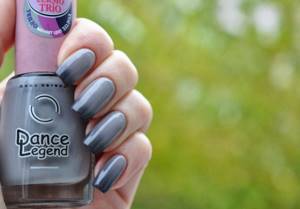
Also in favor are coral, fiery red, cherry, brick, and brown. A manicure made in all shades of blue and purple will look extravagant. Fashionable black a couple of seasons ago (then on short nails) is also acceptable, only more dangerous - you should approach the choice of shape carefully. A calmer, pastel sound in beige, light pink and yellow tones is also relevant - as a kind of nostalgia for summer.
Nowadays you can even fantasize with patterns or create appliqués on your nails. In moderation, of course. You can also do an asymmetrical manicure, placing emphasis on, say, the ring finger. Even decorating a manicure with Swarovski rhinestones has become a sign of good taste!
Removing gel and acrylic
A significant disadvantage of the gel coating is that when removing extended nails, the gel from the nail must be filed away for a long time and tediously. During sawing, a lot of fine dust is produced (cases of allergies to this dust are known). It is strictly not recommended to remove gel nails at home - there is a very high risk of damaging your nails.
Removing acrylic is more “civilized” - just hold the nails in a special solution, after which the acrylic softens and is easy to remove with a spatula. You can do this procedure yourself by purchasing the required solution in the store. Unfortunately, in both cases, your own nails need to be restored after removal.
How do you know which finish is right for your nails?
Any manicure will give you a satisfactory effect, but if you are faced with a choice, then these few recommendations will help you decide.
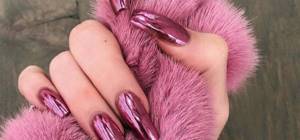
If you want longer nails, then acrylic is your best option. And if you want stronger nails and a long-lasting manicure, gel or shellac are the way to go as they will provide long-lasting, chip-free nails. Shellac works best if you want the most natural effect.
For best results, be sure to go to a well-trained professional and a reputable nail salon.
Found a violation? Report content
Difference in prices for nail extensions with gel and acrylic
Acrylic extensions are still less popular in Russian salons than gel ones; good “acrylic masters” are worth their weight in gold. Therefore, prices for acrylic are often inflated, which is absolutely unjustified from the point of view of the costs of both procedures. In serious salons, prices for acrylic and gel extensions are gradually leveling out, and now they are almost the same:
- extensions under varnish – 2000-3000 rubles,
- extensions with an extension of more than 3 mm - from 3000 rubles,
- French - 2700-3800 TR,
- coverage without extension – 1000-1300 RUR,
- correction - from 50 to 80% of the cost of extensions,
- alteration of one nail – 10% of the cost of extension,
- design – from 70 rub. for the nail,
- modeling – 50-150 rub. per nail.
Prices for withdrawal are more varied and range from 500 to 1300 rubles. for the entire procedure.
What is the difference between the materials

Both substances are nothing more than plastics, derivatives of polymers. Only the method of obtaining is different:
- gel is a kind of jelly that is produced from a polymer under the influence of heat and pressure and hardens under the influence of targeted ultraviolet radiation. The gel smells;
- As soon as you change the parameters, you get not a gel, but a liquid, monomer, liquid and fine powder. They, in contact with oxygen, form acrylic. In fact, acrylic is plexiglass, so it has increased strength and practically does not wear out.
Of course, both plastics are not absolutely safe; they are pure chemistry. But for nail plates the risk is acceptable, as confirmed by Sanitary Regulations and quality certificates. Beauty requires sacrifices, but reasonable ones, not in vain.
The differences between the materials are as follows:
- the gel hardens only under the influence of UV rays, acrylic - on its own;
- gel is self-leveling, acrylic is not;
- gel hardening under a lamp is uncomfortable, acrylic does not give any unpleasant sensations;
- gel smells, acrylic does not;
- acrylic is stronger;
- the gel breathes, since the polymer is porous, the nail grows under such a coating;
- the gel needs to be filed off, acrylic is soluble;
- acrylic does not contain methyl methacrylate, which causes allergies;
- gel gives ideal transparency and shine, acrylic - matte;
- You can’t put a lot of glitter on the gel - this will provoke polymerization, and on acrylic - as much as you want.
